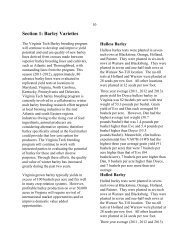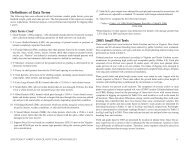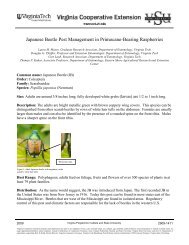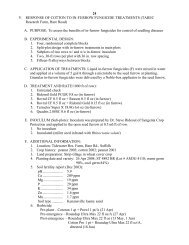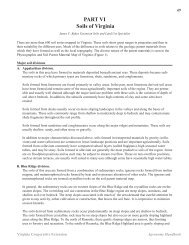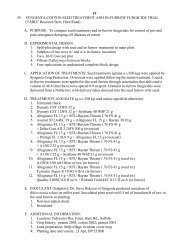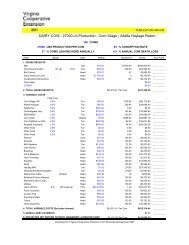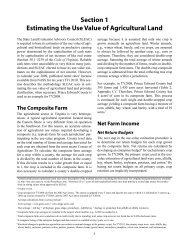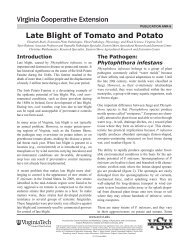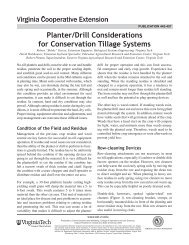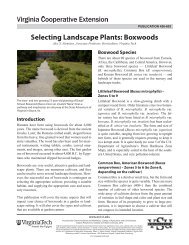PDF (1 MB) - Virginia Cooperative Extension - Virginia Tech
PDF (1 MB) - Virginia Cooperative Extension - Virginia Tech
PDF (1 MB) - Virginia Cooperative Extension - Virginia Tech
Create successful ePaper yourself
Turn your PDF publications into a flip-book with our unique Google optimized e-Paper software.
lay some extra plastic mulch with drip tape this fall! Use the same pre-beds application of<br />
fertilizer and lime you would use for fall-planted strawberries, then add extra nitrogen or<br />
nitro/potash during the crop cycle next year at normal sidedress timings for that enterprise.<br />
For berry growers in colder areas, laying some extra plastic now means you will be in a<br />
position to test-plant some plug plants of Late Star next summer that should be available from<br />
commercial greenhouse-grown mother plants producing greenhouse tips in June.<br />
MINIMIZE STRAWBERRY GRAY MOLD FRUIT ROT NEXT<br />
SPRING<br />
At the 1997 Southeast Strawberry Expo held annually at Raleigh, NC, in November, Laura<br />
Carver, a graduate student at NC State University’s Department of Plant Pathology, presented<br />
an excellent paper on Gray Mold Development and Strawberry Plant Phenology Throughout<br />
The Southeastern Production Season, which we all need to study carefully before next<br />
spring’s big rush! It is too late for controlling Gray Mold now, since plant diseases are only<br />
controlled by prevention. I highly recommend you order a copy of The Proceedings, 1997<br />
SE Strawberry Expo from: NC Strawberry Association, 1138 Rock Rest Road, Pittsboro, NC<br />
27312. Send a check for $10. made to NC Strawberry Association; I guarantee this one paper<br />
is worth far more to growers than the cost of the whole proceedings! I will attempt to provide<br />
a few highlights of this paper to whet your interest, but you need the entire work to plan your<br />
strategy for improved control of Gray Mold fruit rot next spring (especially if it’s another wet<br />
spring such as we had in 1998).<br />
Gray Mold, caused by the fungus Botrytis cinerea, has long been a problem in strawberry<br />
production systems, causing field and postharvest fruit rot. Maturing on dead or dying<br />
plant tissue, the Gray Mold fungus produces small structures termed conidiophores upon<br />
which thousands of microscopic spores are attached. These spores are spread by both wind<br />
and water movement, potentially landing on newly emerging fall and spring leaf tissue,<br />
establishing a latent, resting, grower-invisible infection in fall, winter or early spring, causing<br />
no damage at this point.<br />
Once these leaves naturally senesce or turn brown and die, Gray Mold awakens in early spring<br />
with the advent of warmer temperatures and resumes growth and sporulates, just in time to infect<br />
the newly emerging leaves, then flowers, causing the subsequent development of Gray Mold on<br />
the berries. We should plan to spray during first spring season’s plant growth flush, first bloom,<br />
main bloom and late bloom during spring. If rains of 1/2” or more occur, washing off protective<br />
fungicides for Gray Mold, reapply ASAP. Some said “it was too wet to spray.” Our successful<br />
growers sprayed and resprayed during bloom; they found a way to get the job done between<br />
rains. Yes, they have a big fungicide bill, and a big $500. to $700./acre dead leaves/dead runners<br />
beds cleaning labor bill on carry-over fields, but they have been picking beautiful berries and<br />
selling at premium prices this spring, thanks to El Nino Muy Grande in California.<br />
29



